As science fiction grew beyond comic book and serial adventures in the 40s and 50s, it took 2 basic directions.
-In one school we see pristine white interiors, skin tight jumpsuits, uptight space academy scholasticism, no need for money, and neutral female voices waiting to answer every query.

-In another school we see worlds that are gritty and lived in, with throwbacks to empire, swords, and knighthood.

Guess which school has had the more enduring grasp on the human imagination?
Guess which has better predicted the trajectory of human societies decades into the future?
As it turns out, the latter has aged much better across the decades and resonated with the sensibilities of new generations. The squeaky clean sci fi of perfection in contrast seems a faded dream by comparison. Ironically, it’s the disco age amorphous eggshell swivel chairs with ugly rust orange cushions that no longer look otherworldly to us, but like relics.

Unsurprisingly it’s the sci fi that borrowed from the past to describe the emotional feel of the future that has both outlasted and out-predicted the other.
The utopian school of sci fi thought we’d have pristine Moon and Mars colonies and solved the problem of poverty by now.
The dirty and gritty sci-fi successfully predicted the social upheaval and dark age we actually live in.
One vision saw humans progressing to be something “higher” and therefore different than they were before.
The other simply projected that no matter what technologies you make, people keep on being people with Empires, wars, and famines like there have been for the last thousands of years.
I will also explore a deeper reason why the gritty, humans-will-keep-being-humans sci-fi/space opera settings win.
They communicate the feel of the future viscerally by heavily borrowing from the past.
They take motifs from a time period where advances changed everyone’s lives forever to give us that feeling of a strange new reality. Unsurprisingly, I notice WW1 is perhaps the dominant influence. It was the period that more than any other severed all ties to the thousands of years that came before, that saw the destruction of all the world’s implacable empires in a few years, that saw the apocalyptic slaughter with inhuman new weapons plowing mechanically through countless thousands of lives.
There is also a lot of borrowing from WW2, Korean War, and Vietnam, but WW1 has the advantage of being just distant enough in the collective memory while retaining certain terrible visceral meanings in the collective subconscious.
Some of the most dissonant and disturbing images of WW1 are those of men on horseback or with machine guns wearing gas masks that render us unable to see their humanity underneath.

It perfectly shows us the modern world we take for granted was being born right then and there, a juxtaposition between the familiar and the foreign country of the past.
One of the Best Examples Is Star Wars:
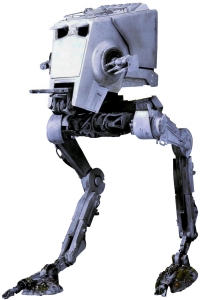
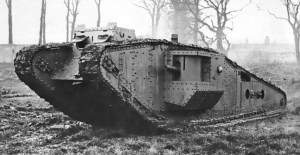
Imperial walker vs. a WW1 tank
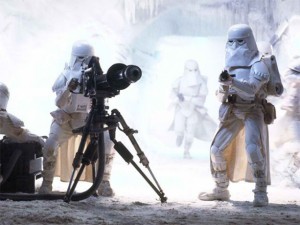
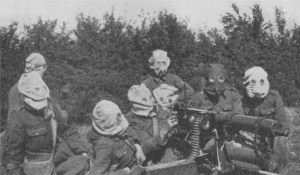
Imperial Snowtroopers vs. WW1 machine gunners
Also, with Star Wars, one of the reasons it resonates is its very retro sound design. It sounds like a failing piston engine when the hyper drive doesn’t work(same sound for airplane engine running out of fuel in Temple of Doom). A lot of the ships fly through space with a grindy noise, like they’ve got V8 engines or they knock about like they have old diesel engines, not hard to believe from the maker of American Graffiti.
The WW1 tanks that inspire the walkers even make an appearance in Last Crusade. With lightsabers you can just hear that circuit click into place before the blade hisses out. The high pitched metallic groans of the carbonite freezer sounds like some sort of real life hydraulic compressor or compactor.
One of the most memorable sounds for me has always been the sinister rushing/zooming/fan noise of the tie fighters. In THX 1138, one of Lucas’ first films, the robot enforcers drove high tech motorcycles that sounded similar. In the clean and pristine worlds of sci fi the sound design tends to be smooth and soothing or else made to sound strange and unfamiliar. It’s the very familiarity of the visual and aural universe of star wars that gives us an immediate connection.
What caps it off of course is setting the mood from the beginning with the words “long ago.” Lucas deliberately studied the structure of Western mythology and this background served him well.
Next I will talk about Dune 1983. The film didn’t live up to its potential as a story but many of the design elements show they knew what they were trying for. The monolithic design of the palaces echoed Ancient Mespotamia, Ancient Egypt, Byzantine/Ottoman architecture brilliantly conveying the feel of an interplanetary civilization that’s been stagnant for thousands of years.
The military uniforms, I will point out, were almost straight out of WW1.


House Atreides Officer vs. Imperial German Officer
We can also compare with some other officers and enlisted…


And while we’re on the subject of uniforms it’s impossible to pass up another Star Wars Example

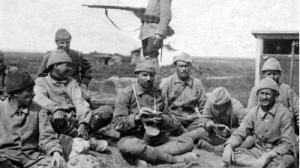

Galactic Empire officers seem like they’re made from a variety of WW1 influences.
And after all these, I hardly even need mention Starcraft or Warhammer 40k which for Terrans and Imperial Guard are basically WW2 in space.
Or for that matter, the Colonial Marines from Aliens who came straight out of Vietnam. Yet James Cameron did do something unique with the design of the marines’ pulse rifles. Some of the best weapon sound design ever, a gritty sound, almost like a growling motor filtered through some kind of sound distorter so it sounded electrical and futuristic at the same time. It perfectly bridged the gap between old and new to create the atmosphere. As if that weren’t good enough, they made the pulse rifles out of tommy guns so there was badass muzzle flare spraying everywhere as they sprayed down rooms with bullets.
I will close with one last example.


In Warhammer 40k, the Space Orks have an aircraft that’s pretty much a Korean war era MiG jet fighter with a machine gun turret taken from a ww2 bomber. A completely impractical idea but somehow, it’s still cooler than handheld phasers resembling electric razors that can vaporize boulders in a few seconds.
See Also: Gustav Holst: Inventor of Modern Sci-Fi Music,Why Star Wars OT Appeals More To Men: Aesthetics





